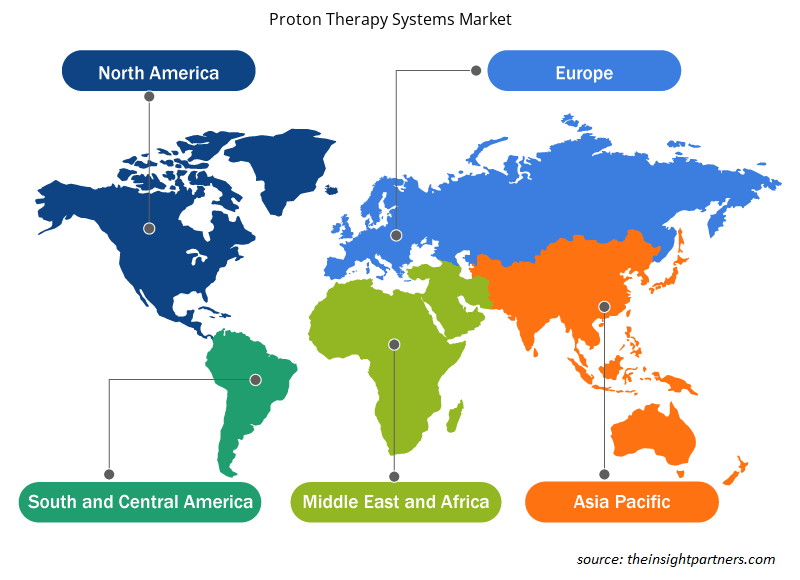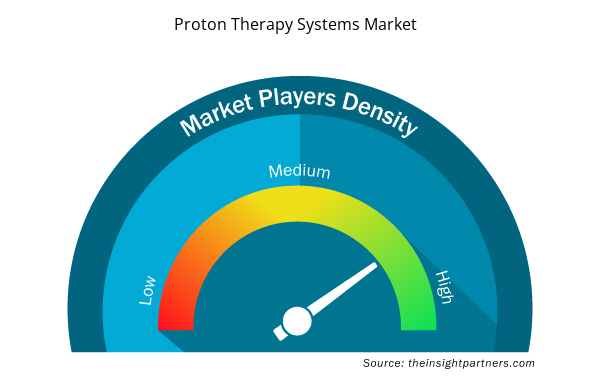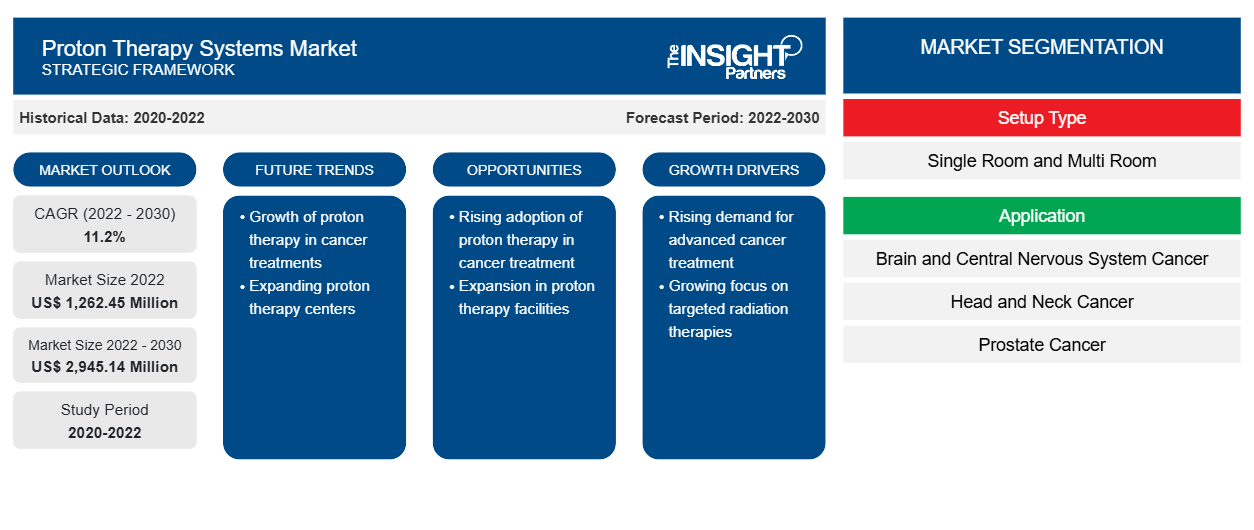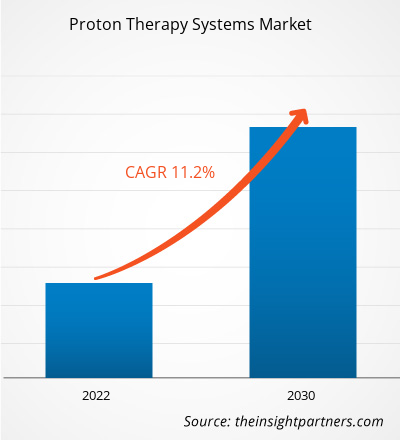[Forschungsbericht] Der Markt für Protonentherapiesysteme soll von 1.262,45 Millionen US-Dollar im Jahr 2022 auf 2.945,14 Millionen US-Dollar im Jahr 2030 wachsen; für den Zeitraum 2022–2030 wird eine durchschnittliche jährliche Wachstumsrate (CAGR) von 11,2 % geschätzt.
Markteinblicke und Analystenansichten:
Die Marktprognose für Protonentherapiesysteme kann den Beteiligten auf diesem Markt dabei helfen, ihre Wachstumsstrategien zu skizzieren.
Ein Protonentherapiesystem ist ein modernes medizinisches Gerät, das zur hochpräzisen Strahlenbehandlung von Tumoren eingesetzt wird. Diese Systeme sind riesig groß und bestehen aus einem Beschleuniger (Zyklotron), einem Strahlentransportsystem, einem Energieauswahlsystem und einer rotierenden Bestrahlungsanlage. Aufgrund ihrer Wirksamkeit bei der Behandlung bestimmter Krebsarten besteht weltweit eine steigende Nachfrage nach Protonentherapie. Faktoren wie die steigende Nachfrage nach modernen Behandlungen aufgrund der steigenden Krebsinzidenz und die zunehmende staatliche Unterstützung von Protonentherapiezentren treiben das Wachstum des Marktes für Protonentherapiesysteme voran. Die hohen Kosten und die große Fläche der Protonentherapiesysteme hemmen jedoch das Wachstum des Marktes. Darüber hinaus wird erwartet, dass die zunehmende Einführung personalisierter Behandlungsansätze mit technologischen Fortschritten in den kommenden Jahren neue Markttrends für Protonentherapiesysteme mit sich bringen wird.
Wachstumstreiber:
Steigende Nachfrage nach fortschrittlichen Behandlungen bei steigender Krebsinzidenz treibt Marktwachstum an
Laut der Internationalen Agentur für Krebsforschung (IARC) hatten Lungenkrebs, Brustkrebs und Prostatakrebs im Jahr 2022 die höchste Inzidenzrate. Diese Krankheiten haben eine altersstandardisierte Rate von 23,6, 47,1 bzw. 29,4 Fällen pro 100.000 Einwohner. Nach Schätzungen der IARC wird die Gesamtzahl der Krebsfälle voraussichtlich von 19,98 Millionen im Jahr 2022 auf 23,71 Millionen im Jahr 2030 und 30,97 Millionen bis 2045 ansteigen. Verschiedene Krebserkrankungen wie Kopf- und Halskrebs (Nasen-, Mund-, Augen- und Kehlkopfkrebs) und Hirntumore haben genaue Behandlungsanforderungen, was zu einer hohen Nachfrage nach fortschrittlichen Behandlungsansätzen wie der intensitätsmodulierten Protonentherapie (IMPT) führt. Bei herkömmlichen Strahlentherapien, etwa der Röntgenstrahlentherapie , erhält auch das gesunde Gewebe um den Tumor herum eine Strahlendosis, was zu Nebenwirkungen führt und Sekundärkrebs verursachen kann. Die Protonentherapie unterstützt jedoch die effektive Behandlung komplizierter Tumore im Gehirn sowie im Kopf- und Halsbereich und minimiert gleichzeitig den Kollateralschaden an benachbarten Geweben. Die hohe Krebsprävalenz und die Nachfrage nach fortschrittlichen Behandlungen steigern daher die Nachfrage nach protonenbasierter Strahlentherapie und befeuern das Marktwachstum für Protonentherapiesysteme.
Passen Sie diesen Bericht Ihren Anforderungen an
Sie erhalten kostenlos individuelle Anpassungen an jedem Bericht, einschließlich Teilen dieses Berichts oder einer Analyse auf Länderebene, eines Excel-Datenpakets sowie tolle Angebote und Rabatte für Start-ups und Universitäten.
- Holen Sie sich die wichtigsten Markttrends aus diesem Bericht.Dieses KOSTENLOSE Beispiel umfasst eine Datenanalyse von Markttrends bis hin zu Schätzungen und Prognosen.
Zurückhaltung:
Hohe Kosten und große Fläche von Protonentherapiesystemen
Ein Protonentherapiesystem ist ein modernes medizinisches Gerät, das zur hochpräzisen Strahlenbehandlung von Tumoren eingesetzt wird. Es handelt sich um ein riesiges medizinisches Gerät, das aus einem Beschleuniger (Zyklotron), einem Strahlentransportsystem, einem Energieauswahlsystem und einer rotierenden Bestrahlungseinrichtung besteht, was zu großen Oberflächen und hohen Gerätekosten führt. Laut der University of Pennsylvania (Oncolink) wiegen Zyklotrone der Protonentherapiesysteme bis zu 200 Tonnen und haben einen Durchmesser von 6–12 Fuß. Das Portal kann 100 Tonnen wiegen und einen Durchmesser von 40 Fuß haben. Laut einer in IOPscience veröffentlichten Studie (2021) nimmt selbst die kompakte Bauweise (Einzelraumaufbau) eine Fläche von 100 Quadratmetern ein, während Protonentherapiesysteme mit mehreren Räumen eine Fläche von 200–400 Quadratmetern einnehmen.
Darüber hinaus sind Protonentherapiesysteme sehr kapitalintensiv. Ein Einzelraumsystem kann beispielsweise fast 30–50 Millionen US-Dollar kosten. Die Kosten für Protonensysteme mit mehreren Gantrys können bei 300 Millionen US-Dollar beginnen und werden normalerweise nur in großen Krankenhäusern und Universitätssystemen installiert. Daher zählen der hohe Kapitalinvestitionsbedarf und die großen Installationsflächen zu den Faktoren, die das Wachstum des Marktes für Protonentherapiesysteme behindern.
Berichtssegmentierung und -umfang:
Die Marktanalyse für Protonentherapiesysteme wurde unter Berücksichtigung der folgenden Segmente durchgeführt: Einrichtungstyp und Anwendung.
Nach Einrichtungstyp ist der Markt in Einzelraum- und Mehrraumsysteme unterteilt. Das Mehrraumsegment hatte im Jahr 2022 einen größeren Marktanteil bei Protonentherapiesystemen. Darüber hinaus wird erwartet, dass das Einzelraumsegment im Prognosezeitraum eine schnellere durchschnittliche jährliche Wachstumsrate verzeichnet.
Der Markt wird nach Anwendung in Hirn- und Zentralnervensystemkrebs, Kopf- und Halskrebs, Prostatakrebs, Brustkrebs, Lungenkrebs , Magen-Darm-Krebs und andere unterteilt. Das Segment Hirn- und Zentralnervensystemkrebs hatte 2022 den größten Marktanteil bei Protonentherapiesystemen und wird im Prognosezeitraum voraussichtlich die höchste durchschnittliche jährliche Wachstumsrate verzeichnen.
Regionale Analyse:
Geografisch umfasst der Marktbericht für Protonentherapiesysteme Nordamerika, Europa, den asiatisch-pazifischen Raum, Süd- und Mittelamerika sowie den Nahen Osten und Afrika. Im Jahr 2022 hatte Nordamerika den größten Marktanteil.Die zunehmende Akzeptanz und Einführung neuester medizinischer Geräte, die hohe Prävalenz von Krebserkrankungen und Produktinnovationen wichtiger Akteure tragen zur Expansion des Marktes für Protonentherapiesysteme in Nordamerika bei. Nach Schätzungen der American Cancer Society verzeichneten die USA im Jahr 2023 etwa 1,95 Millionen neue Krebsfälle und etwa 0,61 Millionen Todesfälle im Zusammenhang mit der Krankheit, was einen deutlichen Anstieg gegenüber den 1,60 Millionen Krebsfällen und 0,60 Millionen Todesfällen im Jahr 2020 darstellt. Laut der Particle Therapy Co-Operative Group verfügten die USA Ende 2023 mit 46 Protonentherapie-Behandlungseinrichtungen über die weltweit höchste Anzahl an Protonentherapiesystemen.
Regionale Einblicke in den Markt für Protonentherapiesysteme
Die regionalen Trends und Faktoren, die den Markt für Protonentherapiesysteme während des Prognosezeitraums beeinflussen, wurden von den Analysten von Insight Partners ausführlich erläutert. In diesem Abschnitt werden auch Marktsegmente und Geografie für Protonentherapiesysteme in Nordamerika, Europa, im asiatisch-pazifischen Raum, im Nahen Osten und Afrika sowie in Süd- und Mittelamerika erörtert.

- Erhalten Sie regionale Daten zum Markt für Protonentherapiesysteme
Umfang des Marktberichts zu Protonentherapiesystemen
| Berichtsattribut | Details |
|---|---|
| Marktgröße im Jahr 2022 | 1.262,45 Millionen US-Dollar |
| Marktgröße bis 2030 | 2.945,14 Millionen US-Dollar |
| Globale CAGR (2022 - 2030) | 11,2 % |
| Historische Daten | 2021-2022 |
| Prognosezeitraum | 2022–2030 |
| Abgedeckte Segmente | Nach Setup-Typ
|
| Abgedeckte Regionen und Länder | Nordamerika
|
| Marktführer und wichtige Unternehmensprofile |
|
Marktteilnehmerdichte für Protonentherapiesysteme: Auswirkungen auf die Geschäftsdynamik verstehen
Der Markt für Protonentherapiesysteme wächst rasant, angetrieben durch die steigende Nachfrage der Endnutzer aufgrund von Faktoren wie sich entwickelnden Verbraucherpräferenzen, technologischen Fortschritten und einem größeren Bewusstsein für die Vorteile des Produkts. Mit steigender Nachfrage erweitern Unternehmen ihr Angebot, entwickeln Innovationen, um die Bedürfnisse der Verbraucher zu erfüllen, und nutzen neue Trends, was das Marktwachstum weiter ankurbelt.
Die Marktteilnehmerdichte bezieht sich auf die Verteilung der Firmen oder Unternehmen, die in einem bestimmten Markt oder einer bestimmten Branche tätig sind. Sie gibt an, wie viele Wettbewerber (Marktteilnehmer) in einem bestimmten Marktraum im Verhältnis zu seiner Größe oder seinem gesamten Marktwert präsent sind.
Die wichtigsten auf dem Markt für Protonentherapiesysteme tätigen Unternehmen sind:
- Varian Medical Systems Inc
- Hitachi GmbH
- Sumitomo Heavy Industries Limited
- Ion Beam Applications SA
- Mevion Medical Systems
Haftungsausschluss : Die oben aufgeführten Unternehmen sind nicht in einer bestimmten Reihenfolge aufgeführt.

- Überblick über die wichtigsten Akteure auf dem Markt für Protonentherapiesysteme
Branchenentwicklungen und zukünftige Chancen:
Nachfolgend sind einige strategische Entwicklungen führender Akteure auf dem Markt für Protonentherapiesysteme aufgeführt, die den Pressemitteilungen der Unternehmen zufolge gelten:
- Im Januar 2024 brachte OncoRay den Prototyp eines Ganzkörper-MRT-gesteuerten Protonentherapiesystems auf den Markt, das die Echtzeitverfolgung beweglicher Tumore mittels Magnetresonanztomographie (MRT) während der Protonentherapie ermöglicht. Die MRT hilft bei der Visualisierung von Tumoren mit verstärktem Kontrast, was ihr großer Vorteil gegenüber herkömmlichen Bildgebungsverfahren ist. Durch den besseren Kontrast lässt sich der Tumor besser vom umgebenden gesunden Gewebe abgrenzen und das zu bestrahlende Volumen genauer definieren.
- Im Dezember 2023 eröffnete die HKSH Medical Group ein neues Protonentherapiezentrum im HKSH Eastern Medical Centre in A Kung Ngam, Shau Kei Wan, Hongkong. Das neue Zentrum verfügt über ein fortschrittliches Protonentherapiesystem und zwei hochmoderne Behandlungsräume. Das System umfasst zwei halbrotierende Protonentherapieportale, das neueste Strahltransportsystem und einen Synchrotron-basierten Beschleuniger.
Wettbewerbslandschaft und Schlüsselunternehmen:
Varian Medical Systems Inc, Sumitomo Heavy Industries Ltd, Hitachi Ltd, Ion Beam Applications SA, Mevion Medical Systems, Provision Healthcare LLC, ProTom International, Optivus Proton Therapy Inc, Advanced Oncotherapy plc und B dot Medical Inc gehören zu den führenden Unternehmen, die im Marktbericht für Protonentherapiesysteme vorgestellt werden. Diese Unternehmen konzentrieren sich auf die Entwicklung neuer Technologien, die Verbesserung bestehender Produkte und die Ausweitung ihrer geografischen Präsenz, um der wachsenden weltweiten Verbrauchernachfrage gerecht zu werden.
- Historische Analyse (2 Jahre), Basisjahr, Prognose (7 Jahre) mit CAGR
- PEST- und SWOT-Analyse
- Marktgröße Wert/Volumen – Global, Regional, Land
- Branche und Wettbewerbsumfeld
- Excel-Datensatz



Report Coverage
Revenue forecast, Company Analysis, Industry landscape, Growth factors, and Trends

Segment Covered
This text is related
to segments covered.

Regional Scope
North America, Europe, Asia Pacific, Middle East & Africa, South & Central America

Country Scope
This text is related
to country scope.
Häufig gestellte Fragen
A proton therapy system is an advanced medical device employed to provide a highly precise radiation treatment for tumors. These systems are huge in size, and they consist of an accelerator (cyclotron), beam transport system, energy selection system, and rotating gantry irradiation equipment. Due to its effectiveness in treating certain types of cancer, there has been a growing demand for proton therapy worldwide.
Factors such as rising demand for advanced treatments with the surging cancer incidence, and increasing government support for proton therapy centers propel the proton therapy systems market growth. However, the high cost and large area of proton therapy systems hamper the growth of the market.
The proton therapy systems market is expected to be valued at US$ 2,945.14 million in 2030.
The proton therapy systems market majorly consists of the players, including Varian Medical Systems Inc, Sumitomo Heavy Industries Ltd, Hitachi Ltd, Ion Beam Applications SA, Mevion Medical Systems, Provision Healthcare LLC, ProTom International, Optivus Proton Therapy Inc, Advanced Oncotherapy plc, and B dot Medical Inc
By setup type, the market is bifurcated into single room and multi room. The multi room segment held a larger proton therapy systems market share in 2022. Further, the single room segment is anticipated to register a faster CAGR during the forecast period.
The proton therapy systems market was valued at US$ 1,262.45 million in 2022.
The market, by application, is categorized into brain and central nervous system cancer, head and neck cancer, prostate cancer, breast cancer, lung cancer, gastrointestinal cancer, and others. The brain and central nervous system cancer segment held the largest proton therapy systems market share in 2022, and it is anticipated to register the highest CAGR during the forecast period.
Trends and growth analysis reports related to Life Sciences : READ MORE..
The List of Companies - Proton Therapy Systems Market
- Varian Medical Systems Inc
- Hitachi Ltd
- Sumitomo Heavy Industries Limited
- Ion Beam Applications SA
- Mevion Medical Systems
- Provision Healthcare LLC
- ProTom International
- Optivus Proton Therapy Inc
- Advanced Oncotherapy plc
- B dot Medical Inc
The Insight Partners performs research in 4 major stages: Data Collection & Secondary Research, Primary Research, Data Analysis and Data Triangulation & Final Review.
- Data Collection and Secondary Research:
As a market research and consulting firm operating from a decade, we have published and advised several client across the globe. First step for any study will start with an assessment of currently available data and insights from existing reports. Further, historical and current market information is collected from Investor Presentations, Annual Reports, SEC Filings, etc., and other information related to company’s performance and market positioning are gathered from Paid Databases (Factiva, Hoovers, and Reuters) and various other publications available in public domain.
Several associations trade associates, technical forums, institutes, societies and organization are accessed to gain technical as well as market related insights through their publications such as research papers, blogs and press releases related to the studies are referred to get cues about the market. Further, white papers, journals, magazines, and other news articles published in last 3 years are scrutinized and analyzed to understand the current market trends.
- Primary Research:
The primarily interview analysis comprise of data obtained from industry participants interview and answers to survey questions gathered by in-house primary team.
For primary research, interviews are conducted with industry experts/CEOs/Marketing Managers/VPs/Subject Matter Experts from both demand and supply side to get a 360-degree view of the market. The primary team conducts several interviews based on the complexity of the markets to understand the various market trends and dynamics which makes research more credible and precise.
A typical research interview fulfils the following functions:
- Provides first-hand information on the market size, market trends, growth trends, competitive landscape, and outlook
- Validates and strengthens in-house secondary research findings
- Develops the analysis team’s expertise and market understanding
Primary research involves email interactions and telephone interviews for each market, category, segment, and sub-segment across geographies. The participants who typically take part in such a process include, but are not limited to:
- Industry participants: VPs, business development managers, market intelligence managers and national sales managers
- Outside experts: Valuation experts, research analysts and key opinion leaders specializing in the electronics and semiconductor industry.
Below is the breakup of our primary respondents by company, designation, and region:

Once we receive the confirmation from primary research sources or primary respondents, we finalize the base year market estimation and forecast the data as per the macroeconomic and microeconomic factors assessed during data collection.
- Data Analysis:
Once data is validated through both secondary as well as primary respondents, we finalize the market estimations by hypothesis formulation and factor analysis at regional and country level.
- Macro-Economic Factor Analysis:
We analyse macroeconomic indicators such the gross domestic product (GDP), increase in the demand for goods and services across industries, technological advancement, regional economic growth, governmental policies, the influence of COVID-19, PEST analysis, and other aspects. This analysis aids in setting benchmarks for various nations/regions and approximating market splits. Additionally, the general trend of the aforementioned components aid in determining the market's development possibilities.
- Country Level Data:
Various factors that are especially aligned to the country are taken into account to determine the market size for a certain area and country, including the presence of vendors, such as headquarters and offices, the country's GDP, demand patterns, and industry growth. To comprehend the market dynamics for the nation, a number of growth variables, inhibitors, application areas, and current market trends are researched. The aforementioned elements aid in determining the country's overall market's growth potential.
- Company Profile:
The “Table of Contents” is formulated by listing and analyzing more than 25 - 30 companies operating in the market ecosystem across geographies. However, we profile only 10 companies as a standard practice in our syndicate reports. These 10 companies comprise leading, emerging, and regional players. Nonetheless, our analysis is not restricted to the 10 listed companies, we also analyze other companies present in the market to develop a holistic view and understand the prevailing trends. The “Company Profiles” section in the report covers key facts, business description, products & services, financial information, SWOT analysis, and key developments. The financial information presented is extracted from the annual reports and official documents of the publicly listed companies. Upon collecting the information for the sections of respective companies, we verify them via various primary sources and then compile the data in respective company profiles. The company level information helps us in deriving the base number as well as in forecasting the market size.
- Developing Base Number:
Aggregation of sales statistics (2020-2022) and macro-economic factor, and other secondary and primary research insights are utilized to arrive at base number and related market shares for 2022. The data gaps are identified in this step and relevant market data is analyzed, collected from paid primary interviews or databases. On finalizing the base year market size, forecasts are developed on the basis of macro-economic, industry and market growth factors and company level analysis.
- Data Triangulation and Final Review:
The market findings and base year market size calculations are validated from supply as well as demand side. Demand side validations are based on macro-economic factor analysis and benchmarks for respective regions and countries. In case of supply side validations, revenues of major companies are estimated (in case not available) based on industry benchmark, approximate number of employees, product portfolio, and primary interviews revenues are gathered. Further revenue from target product/service segment is assessed to avoid overshooting of market statistics. In case of heavy deviations between supply and demand side values, all thes steps are repeated to achieve synchronization.
We follow an iterative model, wherein we share our research findings with Subject Matter Experts (SME’s) and Key Opinion Leaders (KOLs) until consensus view of the market is not formulated – this model negates any drastic deviation in the opinions of experts. Only validated and universally acceptable research findings are quoted in our reports.
We have important check points that we use to validate our research findings – which we call – data triangulation, where we validate the information, we generate from secondary sources with primary interviews and then we re-validate with our internal data bases and Subject matter experts. This comprehensive model enables us to deliver high quality, reliable data in shortest possible time.


 Holen Sie sich ein kostenloses Muster für diesen Bericht
Holen Sie sich ein kostenloses Muster für diesen Bericht